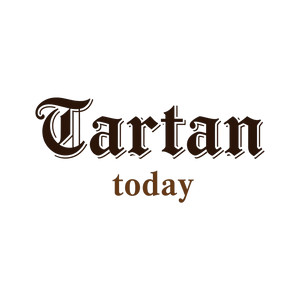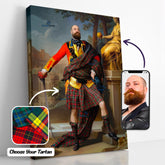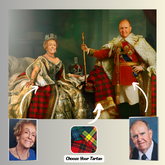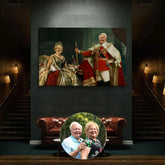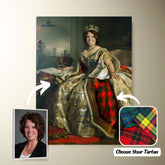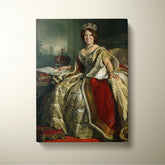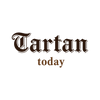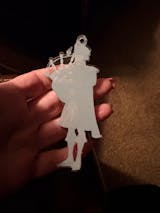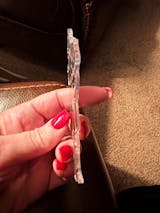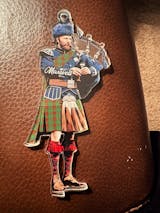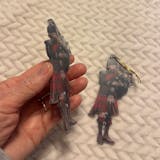-
Personalized Clan Campbell of Breadalbane Ancient Tartan Bagpipe Ornament with Custom Name – Scottish Christmas Tree Decoration OB15
Personalized Clan Campbell of Breadalbane Ancient Tartan Bagpipe Ornament with Custom Name – Scottish Christmas Tree Decoration OB15Celebrate your Scottish heritage with this unique wood & acrylic tartan ornament. Perfect as a personalized Christmas decoration or a meaningful gift for friends and relatives on...- From $19.99 USD
$25.99 USD- From $19.99 USD
- Unit price
- per
Save $6.00 -
Personalized Clan Campbell of Breadalbane Modern Tartan Drummer Ornament with Custom Name – Scottish Christmas Tree Decoration MU48
Personalized Clan Campbell of Breadalbane Modern Tartan Drummer Ornament with Custom Name – Scottish Christmas Tree Decoration MU48Celebrate your Scottish heritage with this unique wood & acrylic tartan ornament. Perfect as a personalized Christmas decoration or a meaningful gift for friends and relatives on...- From $19.99 USD
$25.99 USD- From $19.99 USD
- Unit price
- per
Save $6.00 -
Personalized Clan Campbell of Breadalbane Modern Tartan Bagpipe Ornament with Custom Name – Scottish Christmas Tree Decoration ND54
Personalized Clan Campbell of Breadalbane Modern Tartan Bagpipe Ornament with Custom Name – Scottish Christmas Tree Decoration ND54Celebrate your Scottish heritage with this unique wood & acrylic tartan ornament. Perfect as a personalized Christmas decoration or a meaningful gift for friends and relatives on...- From $19.99 USD
$25.99 USD- From $19.99 USD
- Unit price
- per
Save $6.00 -
Personalized Clan Campbell of Breadalbane Ancient Tartan Drummer Ornament with Custom Name – Scottish Christmas Tree Decoration NZ73
Personalized Clan Campbell of Breadalbane Ancient Tartan Drummer Ornament with Custom Name – Scottish Christmas Tree Decoration NZ73Celebrate your Scottish heritage with this unique wood & acrylic tartan ornament. Perfect as a personalized Christmas decoration or a meaningful gift for friends and relatives on...- From $19.99 USD
$25.99 USD- From $19.99 USD
- Unit price
- per
Save $6.00 -
Personalized Clan Campbell of Breadalbane Reproduction Tartan Bagpipe Ornament with Custom Name – Scottish Christmas Tree Decoration OG23
Personalized Clan Campbell of Breadalbane Reproduction Tartan Bagpipe Ornament with Custom Name – Scottish Christmas Tree Decoration OG23Celebrate your Scottish heritage with this unique wood & acrylic tartan ornament. Perfect as a personalized Christmas decoration or a meaningful gift for friends and relatives on...- From $19.99 USD
$25.99 USD- From $19.99 USD
- Unit price
- per
Save $6.00 -
Personalized Clan Campbell of Breadalbane #2 Reproduction Tartan Bagpipe Ornament with Custom Name – Scottish Christmas Tree Decoration RR20
Personalized Clan Campbell of Breadalbane #2 Reproduction Tartan Bagpipe Ornament with Custom Name – Scottish Christmas Tree Decoration RR20Celebrate your Scottish heritage with this unique wood & acrylic tartan ornament. Perfect as a personalized Christmas decoration or a meaningful gift for friends and relatives...- From $19.99 USD
$25.99 USD- From $19.99 USD
- Unit price
- per
Save $6.00 -
Personalized Clan Campbell of Breadalbane #2 Modern Tartan Bagpipe Ornament with Custom Name – Scottish Christmas Tree Decoration HW20
Personalized Clan Campbell of Breadalbane #2 Modern Tartan Bagpipe Ornament with Custom Name – Scottish Christmas Tree Decoration HW20Celebrate your Scottish heritage with this unique wood & acrylic tartan ornament. Perfect as a personalized Christmas decoration or a meaningful gift for friends and relatives...- From $19.99 USD
$25.99 USD- From $19.99 USD
- Unit price
- per
Save $6.00 -
Personalized Clan Campbell of Breadalbane #2 Ancient Tartan Bagpipe Ornament with Custom Name – Scottish Christmas Tree Decoration EV95
Personalized Clan Campbell of Breadalbane #2 Ancient Tartan Bagpipe Ornament with Custom Name – Scottish Christmas Tree Decoration EV95Celebrate your Scottish heritage with this unique wood & acrylic tartan ornament. Perfect as a personalized Christmas decoration or a meaningful gift for friends and relatives...- From $19.99 USD
$25.99 USD- From $19.99 USD
- Unit price
- per
Save $6.00 -
Personalized Clan Campbell of Breadalbane Ancient Tartan Santa Ornament – Custom Acrylic Christmas Decoration TG53 - Campbell
Personalized Clan Campbell of Breadalbane Ancient Tartan Ornament – Custom Acrylic Christmas Decoration TG53Celebrate your Scottish heritage with this unique wood & acrylic tartan ornament. Perfect as a personalized Christmas decoration or a meaningful gift for friends and relatives on special occasions such as...- From $19.99 USD
- From $19.99 USD
- Unit price
- per
-
Campbell
-
Personalized Clan Campbell of Breadalbane 1819 Modern 2 Clan Crest Tartan Santa Ornament – Custom Acrylic Christmas Decoration IZ78 - Campbell
Personalized Clan Campbell of Breadalbane 1819 Modern 2 Clan Badge Tartan Ornament – Custom Acrylic Christmas Decoration IZ78Celebrate your Scottish heritage with this unique wood & acrylic tartan ornament. Perfect as a personalized Christmas decoration or a meaningful gift for friends and relatives on...- From $19.99 USD
- From $19.99 USD
- Unit price
- per
-
Campbell
-
Personalized Clan Campbell of Breadalbane 1819 Weathered 2 Clan Crest Tartan Santa Ornament – Custom Acrylic Christmas Decoration JD77 - Campbell
Personalized Clan Campbell of Breadalbane 1819 Weathered 2 Clan Badge Tartan Ornament – Custom Acrylic Christmas Decoration JD77Celebrate your Scottish heritage with this unique wood & acrylic tartan ornament. Perfect as a personalized Christmas decoration or a meaningful gift for friends and relatives on...- From $19.99 USD
- From $19.99 USD
- Unit price
- per
-
Campbell
-
Personalized Clan Campbell of Breadalbane 1819 Ancient 2 Clan Crest Tartan Santa Ornament – Custom Acrylic Christmas Decoration GS82 - Campbell
Personalized Clan Campbell of Breadalbane 1819 Ancient 2 Clan Badge Tartan Ornament – Custom Acrylic Christmas Decoration GS82Celebrate your Scottish heritage with this unique wood & acrylic tartan ornament. Perfect as a personalized Christmas decoration or a meaningful gift for friends and relatives on...- From $19.99 USD
- From $19.99 USD
- Unit price
- per
-
Campbell
-
Personalized Clan Campbell of Breadalbane Modern 2 Clan Crest Tartan Santa Ornament – Custom Acrylic Christmas Decoration HI54 - Campbell
Personalized Clan Campbell of Breadalbane Modern 2 Clan Badge Tartan Ornament – Custom Acrylic Christmas Decoration HI54Celebrate your Scottish heritage with this unique wood & acrylic tartan ornament. Perfect as a personalized Christmas decoration or a meaningful gift for friends and relatives on special...- From $19.99 USD
- From $19.99 USD
- Unit price
- per
-
Campbell
-
Personalized Clan Campbell of Breadalbane Ancient 2 Clan Crest Tartan Santa Ornament – Custom Acrylic Christmas Decoration FH57 - Campbell
Personalized Clan Campbell of Breadalbane Ancient 2 Clan Badge Tartan Ornament – Custom Acrylic Christmas Decoration FH57Celebrate your Scottish heritage with this unique wood & acrylic tartan ornament. Perfect as a personalized Christmas decoration or a meaningful gift for friends and relatives on special...- From $19.99 USD
- From $19.99 USD
- Unit price
- per
-
Campbell
-
Personalized Clan Campbell of Breadalbane 1819 Weathered Tartan Santa Ornament – Custom Acrylic Christmas Decoration LG37 - Campbell
Personalized Clan Campbell of Breadalbane 1819 Weathered Tartan Ornament – Custom Acrylic Christmas Decoration LG37Celebrate your Scottish heritage with this unique wood & acrylic tartan ornament. Perfect as a personalized Christmas decoration or a meaningful gift for friends and relatives on special occasions such...- From $19.99 USD
- From $19.99 USD
- Unit price
- per
-
Campbell
-
Personalized Clan Campbell of Breadalbane 1819 Ancient Tartan Santa Ornament – Custom Acrylic Christmas Decoration DX90 - Campbell
Personalized Clan Campbell of Breadalbane 1819 Ancient Tartan Ornament – Custom Acrylic Christmas Decoration DX90Celebrate your Scottish heritage with this unique wood & acrylic tartan ornament. Perfect as a personalized Christmas decoration or a meaningful gift for friends and relatives on special occasions such...- From $19.99 USD
- From $19.99 USD
- Unit price
- per
-
Campbell
-
Personalized Clan Campbell of Breadalbane 1819 Ancient Tartan Santa Ornament – Custom Acrylic Christmas Decoration KW93 - Campbell
Personalized Clan Campbell of Breadalbane 1819 Ancient Tartan Ornament – Custom Acrylic Christmas Decoration KW93Celebrate your Scottish heritage with this unique wood & acrylic tartan ornament. Perfect as a personalized Christmas decoration or a meaningful gift for friends and relatives on special occasions such...- From $19.99 USD
- From $19.99 USD
- Unit price
- per
-
Campbell
-
Personalized Clan Campbell of Breadalbane 1819 Modern Tartan Santa Ornament – Custom Acrylic Christmas Decoration YT68 - Campbell
Personalized Clan Campbell of Breadalbane 1819 Modern Tartan Ornament – Custom Acrylic Christmas Decoration YT68Celebrate your Scottish heritage with this unique wood & acrylic tartan ornament. Perfect as a personalized Christmas decoration or a meaningful gift for friends and relatives on special occasions such...- From $19.99 USD
- From $19.99 USD
- Unit price
- per
-
Campbell
-
Personalized Clan Campbell of Breadalbane 1819 Modern Tartan Santa Ornament – Custom Acrylic Christmas Decoration GP28 - Campbell
Personalized Clan Campbell of Breadalbane 1819 Modern Tartan Ornament – Custom Acrylic Christmas Decoration GP28Celebrate your Scottish heritage with this unique wood & acrylic tartan ornament. Perfect as a personalized Christmas decoration or a meaningful gift for friends and relatives on special occasions such...- From $19.99 USD
- From $19.99 USD
- Unit price
- per
-
Campbell
-
Personalized Clan Campbell of Breadalbane Weathered Tartan Santa Ornament – Custom Acrylic Christmas Decoration YX28 - Campbell
Personalized Clan Campbell of Breadalbane Weathered Tartan Ornament – Custom Acrylic Christmas Decoration YX28Celebrate your Scottish heritage with this unique wood & acrylic tartan ornament. Perfect as a personalized Christmas decoration or a meaningful gift for friends and relatives on special occasions such as...- From $19.99 USD
- From $19.99 USD
- Unit price
- per
-
Campbell
Ex: Your Tartan + Product
Popular Products
Turn Me Royal Personalized Portrait from Your Photo, Custom Tartan. Custom Canvas Wall Art as Gift for Men
- From $32.45 USD
- From $32.45 USD
- Unit price
- / per
Royalty Couple Personalized Portrait from Your Photo, Custom Tartan. Custom Canvas Wall Art
- From $47.45 USD
- From $47.45 USD
- Unit price
- / per
The Queen Personalized Portrait from Your Photo, Custom Tartan. Custom Canvas Wall Art as Gift for Women
- From $32.45 USD
- From $32.45 USD
- Unit price
- / per
Which Clan Are You From?
- Apron
- Campbell
- Campbell of Breadalbane
- Campbell of Breadalbane #2 Ancient
- Campbell of Breadalbane #2 Modern
- Campbell of Breadalbane #2 Reproduction
- Campbell of Breadalbane 1819 Ancient
- Campbell of Breadalbane 1819 Ancient 2
- Campbell of Breadalbane 1819 Modern
- Campbell of Breadalbane 1819 Modern 2
- Campbell of Breadalbane 1819 Weathered
- Campbell of Breadalbane 1819 Weathered 2
- Campbell of Breadalbane Ancient
- Campbell of Breadalbane Ancient 2
- Campbell of Breadalbane Ancient Tartan
- Campbell of Breadalbane Modern
- Campbell of Breadalbane Modern 2
- Campbell of Breadalbane Modern Tartan
- Campbell of Breadalbane Reproduction
- Campbell of Breadalbane Tartan
- Campbell of Breadalbane Weathered
- Scott
List Of Tartan
-
Clan A
- Abercrombie Tartan
- Aberdeen Tartan
- Abernethy Tartan
- Adair Tartan
- Adam Tartan
- Ayrshire Tartan
- Agnew Tartan
- Aikenhead Tartan
- Ainslie Tartan
- Aiton Tartan
- Allan Tartan
- Alexander Tartan
- Allardice Tartan
- Allison Tartan
- Anderson Tartan
- Angus Tartan
- Anstruther Tartan
- Arbuthnot Tartan
- Armstrong Tartan
- Arnott Tartan
- Auchinleck Tartan
- Ayrshire Tartan
-
Clan B
- Baillie Tartan
- Bain Tartan
- Baird Tartan
- Balfour Tartan
- Bannatyne Tartan
- Bannerman Tartan
- Barclay Tartan
- Baxter Tartan
- Beaton Tartan
- Bell Tartan
- Belshes Tartan
- Bethune Tartan
- Beveridge Tartan
- Binning Tartan
- Bisset Tartan
- Blackadder Tartan
- Blackstock Tartan
- Black Watch Tartan
- Blair Tartan
- Blane Tartan
- Blyth Tartan
- Borthwick Tartan
- Boswell Tartan
- Bowie Tartan
- Boyd Tartan
- Boyle Tartan
- Brisbane Tartan
- Brodie Tartan
- Brown/ Broun Tartan
- Bruce Tartan
- Buccleuch Tartan
- Buchan Tartan
- Buchanan Tartan
- Burnett Tartan
- Burns Tartan
- Butter Tartan
- Byres Tartan
-
Clan C
- Cairns Tartan
- Calder Tartan
- Callander Tartan
- Cameron Tartan
- Campbell Tartan
- Campbell of Breadalbane Tartan
- Campbell of Cawdor Tartan
- Carmichael Tartan
- Carnegie Tartan
- Carruthers Tartan
- Cathcart Tartan
- Chalmers Tartan
- Charteris Tartan
- Chattan Tartan
- Cheyne Tartan
- Chisholm Tartan
- Christie Tartan
- Clark Tartan
- Clelland Tartan
- Clephan Tartan
- Clergy Tartan
- Cochrane Tartan
- Cockburn Tartan
- Colquhoun Tartan
- Colville Tartan
- Cooper Tartan
- Couper Tartan
- Craig Tartan
- Cranstoun Tartan
- Crawford Tartan
- Crichton Tartan
- Crief District Tartan
- Crosbie Tartan
- Cumming Tartan
- Cunningham Tartan
- Currie Tartan
- Clan D
- Clan E
- Clan F
- Clan G
- Clan H
- Clan I
- Clan J
- Clan K
- Clan L
-
Clan M
- Maitland Tartan
- Malcolm Tartan
- Mar Tartan
- Marjoribanks Tartan
- Maxtone Tartan
- Matheson Tartan
- Maule Tartan
- Maxwell Tartan
- Meldrum Tartan
- Melville Tartan
- Menzies Tartan
- Mercer Tartan
- Middleton Tartan
- Moffat Tartan
- Moncrieffe Tartan
- Montgomery Tartan
- Monypenny Tartan
- Moncreiffe Tartan
- Monteith Tartan
- Morrison Tartan
- Mouat Tartan
- Moubray Tartan
- Mow Tartan
- Muir_More Tartan
- Muirhead Tartan
- Munro Tartan
- Murray Tartan
- Murray of Atholl Tartan
-
Clan Mc/Mac
- MacAlister Tartan
- MacArthur Tartan
- MacAlpine Tartan
- MacAulay Tartan
- MacBain Tartan
- MacBean Tartan
- MacBeth Tartan
- MacCallum Tartan
- MacCraig Tartan
- MacColl Tartan
- MacCorquodale Tartan
- MacDiarmid Tartan
- MacDonald Tartan
- MacDonald of Clanranald Tartan
- MacDonald of Sleat Tartan
- MacDonnell of Glengarry Tartan
- MacDonnell of Keppoch Tartan
- MacDougall Tartan
- MacDowall Tartan
- MacDuff Tartan
- MacEwen_MacEwan Tartan
- MacEdward Tartan
- MacFarlane Tartan
- MacGill Tartan
- MacGillivray Tartan
- MacGregor Tartan
- MacGowan (McGowan) Tartan
- MacHardy Tartan
- MacIan Tartan
- MacInnes Tartan
- MacIntyre Tartan
- MacKay Tartan
- MacKillop Tartan
- MacKellar Tartan
- Mackinlay Tartan
- MacKenzie Tartan
- Mackie Tartan
- MacKinnon Tartan
- MacKintosh / MacIntosh Tartan
- MacLeod Tartan
- MacMillan Tartan
- MacNab Tartan
- MacNaughton Tartan
- MacNeil / MacNeill Tartan
- MacNeil of Colonsay Tartan
- MacNicol Tartan
- MacPhail Tartan
- MacPhee_MacFie Tartan
- MacPherson Tartan
- MacQuarrie Tartan
- MacQueen Tartan
- MacRae Tartan
- MacRow Tartan
- MacSporran Tartan
- MacTaggart Tartan
- MacTavish Tartan
- MacThomas Tartan
- McCorquodale Tartan
- McCulloch Tartan
- McFadzen Tartan
- McGeachie Tartan
- McIver Tartan
- McKerrell Tartan
- Clan N
- Clan O
- Clan P
- Clan R
-
Clan S
- Sandilands Tartan
- Scott Tartan
- Scrymgeour Tartan
- Selkirk Tartan
- Sempill Tartan
- Seton Tartan
- Shaw Tartan
- Shepherd Tartan
- Sinclair Tartan
- Skene Tartan
- Skirving Tartan
- Smith Tartan
- Somerville Tartan
- Spalding Tartan
- Spens Tartan
- Spottiswood Tartan
- Stevenson Tartan
- Stewart Tartan
- Stewart of Appin Tartan
- Stirling Tartan
- Strachan Tartan
- Straiton Tartan
- Strange Tartan
- Strathclyde District Tartan
- Stuart of Bute Tartan
- Sutherland Tartan
- Swinton Tartan
- Clan T
- Clan U W Y
- Request Your Clan
Campbell of Breadalbane Clan (Campbell of Breadalbane Tartan)
1. About Campbell of Breadalbane Clan (Campbell of Breadalbane Tartan)
2. Campbell of Breadalbane History (Campbell of Breadalbane Tartan)
After the House of Argyll, the Campbells of Breadalbane are the dominant family.
R.R. McIan's illustration from the 19th century depicts a Campbell of Breadalbane clansman
Colin, also known as "Black Colin of Glenorchy," was born to Sir Duncan Campbell, Knight of Lochow, 1st Lord Campbell, and his wife Lady Marjory Stewart.
Glenorchy was given to Sir Duncan's son by the MacGregors after they were expelled. One of Lord Lorn's daughters was married to Sir Colin.
He received a third of the Lorn estate thanks to this union. He was made a Knight of Rhodes in recognition of his courage during a Crusade to Palestine. He constructed Kilchurn Castle as the family seat in 1440.
The succeeding line was outstanding in their acquisition of land and property, extending into the regions of Argyll and Perthshire as well as Finlarig, Glenlyon, and other places.
The MacGregor family was expelled from Glenstrae in front of Kilchurn in 1603, thanks to the deceit and aristocratic pressures of Sir Colin of Glenorchy.
Black Duncan, 7th of Glenorchy, who was dubbed "Black Duncan," was made a baronet in 1625, and Sir John, 11th of Glenorchy, who was dubbed "cunning as a fox, wise as a serpent, and slippery as an eel," was made the first Earl of Breadalbane in 1681.
A group from Scotland approached William of Orange and offered him the Scottish throne when he arrived in London as the Sovereign in 1688.
William took an oath, which was administered by Argyll, promising to purge the Scottish lands and empire of "all heretics and enemies to the true worship of God that shall be convicted by the true Kirk of God of the aforesaid crimes."
The Campbells had previously planned to murder their Catholic neighbors, the MacDonalds of Glencoe.
King William was convinced to sign the order by Dalrymple of Stair, and the 1st Earl of Breadalbane was handed a purse of public funds to appease the other Highland leaders, albeit some compulsion was also necessary.
Although the Earl expertly disguised from the courts his involvement in the massacre, the Breadalbane line has since experienced bad luck.
The more contemporary Taymouth Castle was dispersed, and the original family seat is now a ruin.
3. Campbell of Breadalbane Tartans
The Cockburn collection, one of the first collections of tartans, dates from 1810 to 1820 and is where the Campbell of Breadalbane tartan first appears as "Breadalbane." Sir William Cockburn was the collector of these tartans.
Given that it is supposed to have been replicated from a plaid that belonged to the Captain of Dunstaffnage in Dunstfanage around 1750, it may perhaps be older.
While "modern" colors are typically darker, the phrase "ancient" relates to the dye tones, which are typically lighter.
Y4 G18 K/18 Threadcound K/6 B18 K18 G18
Campbell of Breadalbane Ancient
Campbell of Breadalbane Modern
4. Clan Campbell of Breadalbane Crest & Coats of Arms
4.1 Clan Campbell of Breadalbane Crest
Worn by all of the name and ancestry
4.2 Clan Campbell of Breadalbane Coat of Arms
EARL OF BREADALBANE
(CAMPBELL OF GLENORCHY) Quarterly, first and fourth gyronny of eight Or and Sable, second a galley in Argent. Sable, third, Or, a fess crosslet of Azure and Argent. 1672–1707 Ordinary of Arms
5. Clan Campbell of Breadalbane Places & People
5.1 Clan Campbell Places
The Innis Chonnell family had lived in a fortified fortress that spanned the entire island of Loch Awe. The peaks of Cruachan Beann, the hills from which the Campbells drew their war cry, rise behind it.
On Innis Chonnell, the ruins of the castle are still discernible among the trees. It served as Sir Colin Campbell's home and the Campbell family's first stronghold until it was abandoned in the fifteenth century.
Sir Colin Campbell was killed at The Battle of Red Ford.
The Glowm estate in Clackmannanshire, subsequently known as Castle Campbell, was bought by the 1st Earl of Argyll and served as the Campbell family's seat in the Lowlands from the 15th to the 19th centuries.
The Earl's requirement to appear in court was satisfied by the position of Glown (Castle Campbell).
The MacDonalds, Lords of the Isles, were the 1st Earl of Argyll's longtime adversaries, and he played a key role in their downfall.
King James V visited the castle at Inveraray in 1533, therefore it has existed on these lands at least since the 15th century.
The previous fortification was replaced by the current Inveraray Castle, which was constructed between 1743 and 1746. One of the first instances of Gothic Revival architecture in existence is seen in the castle.
The 13th Duke of Argyll, Torquhil Campbell, resides at Inveraray Castle, which has served as the family seat of the Campbell Dukes of Argyll since the 18th century.
5.2 Clan Campbell People
5.2.1 Sir Henry Campbell–Bannerman (1836-1908)
The future Lord Provost's son, who would become the British Prime Minister from 1905 to 1908, was born in Glasgow.
He hyphenated his mother's name Bannerman with his father's Campbell in order to inherit the wealth of a deceased uncle.
Before serving as the liberal MP for Stirling for the remainder of his life, he completed studies in Glasgow and Cambridge.
Throughout his career, he served a variety of ministerial positions and was knighted in 1895. He was said to as a tenacious fighter, supporter of the suffragette movement, and advocate for the Boers' right to self-government.
Winston Churchill, Lloyd George, and Henry Herbert Asquith served in his cabinet while he was prime minister; nevertheless, as his health declined, he was forced to withdraw from politics and passed away within a fortnight.
5.2.2 Sir Colin Campbell, Lord Clyde (1792-1863)
According to a legend, Colin MacIver adopted his mother's maiden name after hearing the Duke of York recommend Campbell as a name for a soldier.
The Glasgow carpenter's son, Colin Campbell, advanced through the British Army's ranks and was given the title of Field Marshall in 1862.
He distinguished himself in battle in China, the West Indies, India, and the Crimea, where he led the Highland Brigade to victory in the Battle of Alma before continuing the fight against the Russian Cavalry at Balaclava with "the Thin Red Line."
He is remembered as a military titan of the British Empire in the middle of the 19th century, and his remains is interred at Westminster Abbey.
5.2.3 Sir Malcolm Brown Campbell (1848-1935)
The famed Malcolm Campbell grocery chain's founder experienced a journey from poverty to affluence.
He tried to bring the world's products to the high street from the time of his birth in Kilwinning, Ayrshire, and while doing errands for a greengrocer in Glasgow, developing fruit and vegetable sales.
He was the person who introduced bananas to Scotland. His choice of railroad stations as potential locations for his kiosks played a significant role in his success. His accomplishments led to his knighthood in 1922.
5.2.4 Angus Campbell (1903-82)
Angus Campbell, also known as Am Puilean, was a poet and author who was raised in the Isle of Lewis settlement of Ness.
He was a prisoner of war in Poland during World War II. His book of Gaelic poetry, titled "Chaff & Wheat," was published in 1972. His autobiography, "Touching Many Headlands," was released the year after.
6. Associated Names
The Breadlebane or Glenorchy branches make up Clan Campbell's Breadlebane branch.
- Choosing a selection results in a full page refresh.
